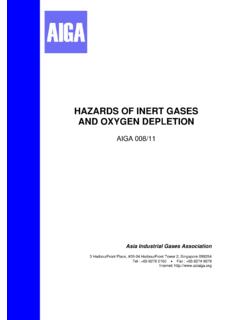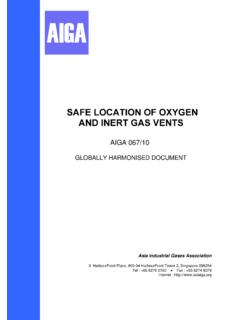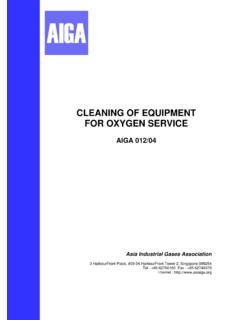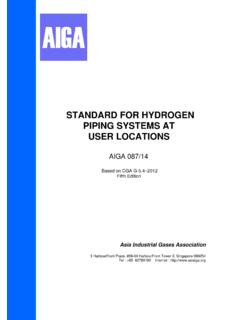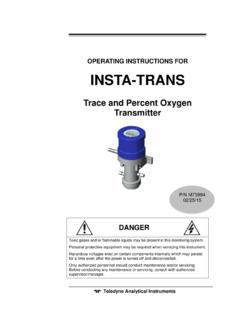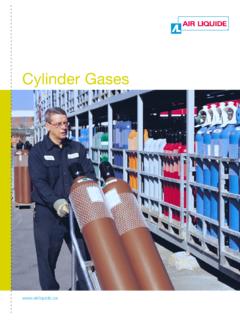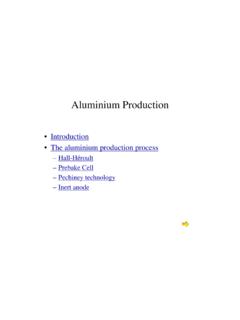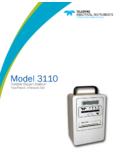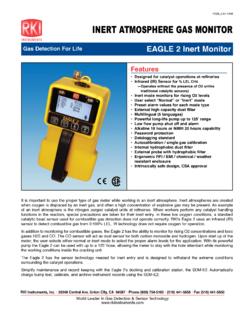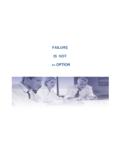Transcription of LIQUID OXYGEN, NITROGEN AND ARGON …
1 LIQUID oxygen , NITROGEN AND. ARGON cryogenic TANKER. LOADING SYSTEMS. AIGA 085/13. Based on CGA P-31 2013 3rd edition Asia Industrial Gases Association 3 HarbourFront Place, #09-04 HarbourFront Tower 2 Singapore 099254. Tel : +65 6276 0160 Fax : +65 6274 9379. Internet : AIGA 085/13. LIQUID oxygen , NITROGEN AND. ARGON cryogenic TANKER. LOADING SYSTEMS. NOTE Technical changes from the previous edition are underlined. Disclaimer All publications of AIGA or bearing AIGA's name contain information, including Codes of Practice, safety procedures and other technical information that were obtained from sources believed by AIGA to be reliable and/ or based on technical information and experience currently available from members of AIGA and others at the date of the publication.
2 As such, we do not make any representation or warranty nor accept any liability as to the accuracy, completeness or correctness of the information contained in these publications. While AIGA recommends that its members refer to or use its publications, such reference to or use thereof by its members or third parties is purely voluntary and not binding. AIGA or its members make no guarantee of the results and assume no liability or responsibility in connection with the reference to or use of information or suggestions contained in AIGA's publications. AIGA has no control whatsoever as regards, performance or non performance, misinterpretation, proper or improper use of any information or suggestions contained in AIGA's publications by any person or entity (including AIGA members) and AIGA expressly disclaims any liability in connection thereto.
3 AIGA's publications are subject to periodic review and users are cautioned to obtain the latest edition Reproduced with permission from, the Compressed Gas Association. All rights reserved. ASIA INDUSTRIAL GASES ASSOCIATION. 3 HarbourFront Place, #09-04 HarbourFront Tower 2 Singapore 099254. Tel: +65 62760160 Fax: +65 62749379. Internet: Contents Page 1 1. 2 Scope and purpose .. 1. Scope .. 1. Purpose .. 1. 3 2. 4 Hazards .. 3. Enhanced flammability .. 3. Asphyxiation .. 3. Personnel exposures .. 3. Material embrittlement .. 3. Fog .. 3. Vapor 3. Overpressurization .. 3. 5 System design considerations .. 4. Filling area layout .. 4. Filling operations .. 4. Design choices .. 4. LIQUID oxygen 5. 5. Product analysis .. 6. Working surfaces .. 6. Lighting.
4 6. Operator controls .. 7. 6 Inadvertent pull away .. 7. Definition of 7. Filling area .. 7. Design considerations .. 7. Operating and design practices .. 7. Anti-pull away devices .. 8. Damage control devices .. 9. 7 Overfill protection .. 9. Definition of overfill .. 9. Overfilling avoidance .. 9. Response to overfilling .. 10. System design and operating considerations .. 10. 8 Overpressure Protection .. 10. 9 Contamination .. 11. Fittings .. 11. Quality assurance for incoming trailers .. 11. 10 Operator training emergency response .. 11. Training of personnel .. 11. Emergency procedures .. 11. 11 References .. 11. iii AIGA 085/13. 1 Introduction This document has been prepared by member associations of the International Harmonization Council, under the lead of CGA and is intended for the worldwide use and application by all members of the International Harmonization Council.
5 The International Harmonization Council is composed of members from the Asia Industrial Gases Association, Compressed Gases Association, CGA, European Industrial Gases Association, EIGA, and the Japanese Industrial and Medical Gases Association. Regional editions may use non SI units and refer to national, and or regional legislation. This document has been compiled in response to the demand for information relating to the loading of cryogenic LIQUID oxygen (LOX), NITROGEN (LIN), and ARGON (LAR). 2 Scope and purpose Scope This publication describes requirements for installations designed and constructed after the publication date of this document used for the loading of oxygen , NITROGEN , or ARGON as cryogenic liquids. This publication may be used for existing cryogenic LOX, LIN, and LAR loading systems.
6 Application of this publication to existing installations is an individual company or storage system owner's decision. This publication covers cryogenic LOX, LIN, and LAR tanker loading systems for loading by gravity, pressure, or pump filling. It covers the design of the tanker loading systems and the period of time and activities between when a tanker enters the filling area and when it departs from the filling area. This publication focuses on the factors affecting the transfer of oxygen , NITROGEN , and ARGON as cryogenic liquids between a source and appropriately designed tankers used for the transportation of these products. The source can be either a storage tank or directly from the plant. For the appropriate design of tankers, refer to the mandatory standards to be followed in the countries.
7 For the appropriate design of tankers (applicable to the United States of America), refer to CGA-341, Standard for Insulated Cargo Tank Specification for Nonflammable cryogenic Liquids; ASME Boiler & Pressure Vessel Code - Section XII Rules for the Construction & Continued Service of Transport Tanks; International Standard ISO 20421-1 cryogenic vessels - Large transportable vacuum-insulated vessels - : Design, Fabrication, Inspection and Testing; Title 49 of the Code of Federal Regulations (49 CFR) Part ; CSA B620, Highway Tanks and Portable Tanks for the Transportation of Dangerous Goods; and CSA B622, Selection and Use of Highway Tanks, Multi-unit Tank Car Tanks, and Portable Tanks for the Transportation of Dangerous Goods, Class 2 [1, 2, 3, 4, 5, 6].1.
8 It does not cover cryogenic rail cars nor does it cover tankers unloading at a customer station or other user location. Purpose The purpose of this publication is to provide information regarding safety in the design, installation, operation, and maintenance of cryogenic LOX, LIN, and LAR tanker loading systems. The intent of this publication is to ensure that a uniform level of safety is provided throughout the industrial gas industry for the protection of the public and industry employees. The information presented does not replace but is intended to complement national, state, provincial/territorial, local, and insurance company safety requirements. Through implementation of procedures, instrumentation, equipment inspection, testing, and system design criteria, this publication presents recommendations to reduce the potential for large releases of stored materials from storage systems or tankers.
9 It emphasizes prevention of releases rather than mitigation of consequences following a release. 1. References are shown by bracketed numbers and are listed in order of appearance in the reference section. 1. AIGA 085/13. This publication is intended to facilitate proper decisions in the design, implementation, and modification of materials and equipment for the efficient handling of cryogenic LOX, LIN, and LAR in filling cryogenic tankers. This publication is written for designers, owners, and operators of cryogenic LIQUID tanker loading systems. 3 Definitions For the purpose of this publication, the following definitions apply. Publication terminology Shall Indicates that the procedure is mandatory. It is used wherever the criterion for conformance to specific recommendations allows no deviation.
10 Should Indicates that a procedure is recommended. May Indicates that the procedure is optional. Can Indicates a possibility or ability. cryogenic LIQUID LIQUID with a boiling point below 130 F ( 90 C) at atmospheric pressure. Filling area Location where tankers are parked, connected, and filled with cryogenic LIQUID . The filling area includes the loading hoses, piping, valves, and related equipment. Getter Material that, when used in closed containers, reduces the gas or vapor content of the container. NOTE A getter can react with the gas or vapor in the container to form a solid nonvaporizable material, absorb the gas or vapor, or reduce the amount of the gas or vapor in the container in any other way. The material might be a getter for one gas or vapor and might not have any effect upon another gas or vapor.
